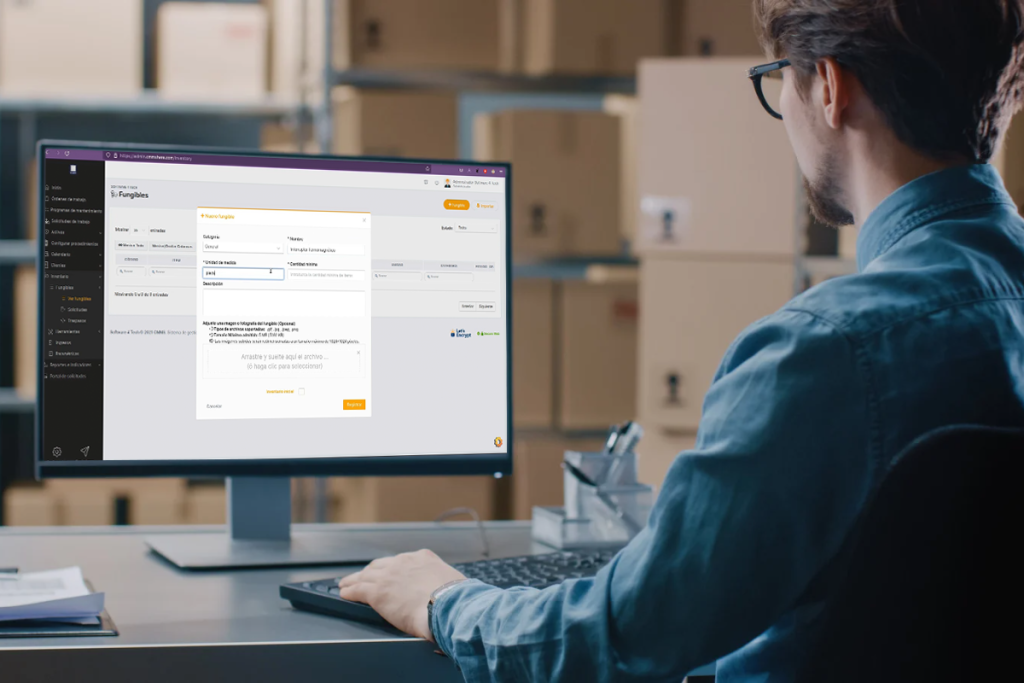|
Escuchar artículo
Getting your Trinity Audio player ready...
|
Within the maintenance area, Inventory refers to the list of all equipment, tools, spare parts and supplies that are available in a company or facility for maintenance. Inventory is important because it helps ensure that you have the items you need to perform maintenance and repairs efficiently and effectively.
Maintenance inventory can range from simple hand tools to complex spare parts for critical equipment. It can also include supplies such as lubricants, standing stock nutritional plans, cleaning and disinfecting chemicals and safety materials.

Maintenance inventory control is essential to ensure that sufficient stock of critical items is held, allowing maintenance tasks to be performed in a timely manner and avoiding unnecessary delays due to lack of tools or parts. Also, proper management of maintenance inventory helps minimize company costs by avoiding excess inventory and the need to place emergency orders.
What challenges are presented in the management of inventories in the maintenance area?
Inventory management in the maintenance area can present several challenges, including:
- Sobreabastecimiento o falta de inventario:Overstock or understock: If there is too much inventory in the maintenance warehouse, it can be costly and take up valuable space that could be used for other functions. On the other hand, if there is a lack of inventory, maintenance work can be delayed, which can lead to long downtime and lost production..
- Lack of inventory tracking and updating: If the inventory is not properly tracked and updated, there is a risk of missing essential parts and tools, which could cause delays in the maintenance work, this challenge is easily overcome with the implementation and execution of a CMMS that allows visibility of stocks, movements, requirements and feeding work orders with the necessary resources and thus carry and track an adequate maintenance cost, in order to know the periodic costs of the area at a single click.
- Loss of items: Tools and spare parts may be misplaced or disappear, which may result in having to be purchased or remanufactured, increasing costs and potentially causing delays in performing maintenance work.
- Obsolescence: Spare parts and maintenance equipment can also become obsolete over time, so it is important to monitor inventory levels to avoid having unnecessary or outdated part.
- To address these challenges, it is important to maintain tight inventory control, establish clear policies and procedures for maintenance inventory management, conduct regular inventory audits, and use maintenance information systems that allow for real-time inventory tracking and updating.

If there are no inventories of spare parts for critical assets, this is what the maintenance area faces:
Lack of critical equipment maintenance inventories in industry can have a significant impact on business efficiency, productivity and costs. Some of the problems that can arise include:
- Prolonged downtime: If a piece of equipment fails and you don’t have the necessary parts to repair it, there can be a prolonged interruption in production, which can result in significant financial losses for the company.
- Shipping and emergency storage costs: If the company needs to order parts urgently, it may incur high shipping costs, especially if it needs to import parts from abroad. It may also be necessary to find temporary storage space for the parts, which can be costly.
- Delay in preventive maintenance: Lack of critical inventories can delay preventive maintenance, which can increase the risk of equipment failure and increase the cost of repair work..
- Reduced equipment life: If equipment is not properly maintained due to lack of critical inventory, it is more likely to wear out and break down more frequently. This can reduce equipment life and increase replacement costs.

To avoid these problems, it is important for companies to properly manage maintenance inventory and ensure that they have sufficient critical parts in stock. This includes keeping detailed inventory records, monitoring inventory levels, establishing inventory replenishment policies, and setting up an early warning system to detect potential problems. In this way, you can ensure that equipment is available and in good condition to maintain the company’s efficiency and productivity.
Actions to implement for good inventory management in the maintenance area:
For a proper inventory management in the maintenance area in a medium or small company, the following policies and actions can be implemented:
- Perform a detailed initial inventory: The first step for a good inventory management in the maintenance area is to know the current inventory. It is necessary to make a detailed inventory of all equipment, tools, spare parts and supplies in the maintenance warehouse.
- Establish an inventory control and tracking system: An inventory control and tracking system should be established to monitor stock levels, record incoming and outgoing inventory, and detect possible problems or deviations.
- Establish replenishment policies: It is important to establish clear policies for inventory replenishment, including reorder points, minimum and maximum inventory quantities, and supplier lead times.
- Prioritize critical items: Critical inventory items should be identified and prioritized, i.e., those items that are necessary for the ongoing maintenance of equipment and to avoid prolonged downtime.
- Track demand and usage: Demand and usage of inventory items should be tracked to adjust replenishment policies and ensure that sufficient inventory is held to meet maintenance needs.
- Establish an early warning system: An early warning system can be implemented to detect potential inventory problems, such as stock-outs or obsolescence, and allow preventive action to be taken.
- Training personnel: It is important to train maintenance personnel in inventory management so that they can properly track inventory and make informed decisions on replenishment.

These actions can be implemented for a good inventory management in the maintenance area of a medium or small company. By implementing these policies and actions, you can improve efficiency, reduce costs and ensure a smooth operation of the maintenance area.
What are the cost components of inventory in maintenance processes
The cost components of an inventory of spare parts and supplies for the maintenance area may include the following:
- Acquisition cost: This is the cost paid for parts or inputs when they are first acquired. It includes the purchase price of the parts, transportation cost and other related expenses.
- Storage cost: This cost includes the cost of storage space, the cost of shelving, the cost of electricity to keep the warehouse in operation and other costs associated with storage.
- Obsolescence cost: This is the cost incurred when parts or supplies become obsolete or are not used for an extended period of time. It includes loss of value due to depreciation or deterioration, as well as disposal or recycling costs.
- Replacement cost: This cost is incurred when a part or input is replaced due to failure or end of life. It includes the cost of the new part or input, transportation cost and other related expenses.
- Downtime cost: This is the cost incurred when equipment is idle due to lack of parts or consumables necessary for its maintenance. It includes the loss of production, the cost of repairing the equipment and other expenses associated with the interruption of production.
- Safety cost: This cost includes the cost of safety procedures necessary to store and handle parts and supplies safely. It includes the cost of safety equipment, the cost of training and other safety-related expenses.
The best strategy to manage a good asset maintenance inventory turnover
The best strategy to execute an optimal rotation of the inventories of the maintenance area may involve the following steps:
- Classify inventory items: It is important to classify inventory items according to their importance, frequency of use and cost. This will help identify the items that should be stored in larger quantities and those that are used less frequently.
- Establish an optimum inventory level: It is important to establish an optimum inventory level for each item, taking into account its classification and expected demand. This will help to avoid overproduction and the accumulation of unnecessary inventory.
- Implement replenishment policies: It is important to establish replenishment policies for each item, taking into account demand and supplier lead time. This will help maintain inventory at optimal levels and avoid parts shortages.
- Track inventory: It is important to track inventory on a regular basis to ensure that optimal inventory levels and established replenishment policies are being met.
- Implementar un sistema de gestión de inventarios: Es importante implementar un sistema de gestión de inventarios que permita hacer un seguimiento de los niveles de inventario, la demanda y las políticas de reposición. Esto puede ayudar a automatizar el proceso y garantizar que se cumplan las políticas establecidas.
- Use ABC analysis: The ABC analysis technique consists of classifying inventory items into three categories according to their importance, with A being the most important, B the intermediate and C the least important. This allows you to focus on the most important items and ensure that you have sufficient inventory available for them.

How can you control and organize inventory in the CMMSHere?
The following are some recommendations for controlling and organizing spare parts inventory at CMMSHere:
- Establish a classification structure: It is important to establish a logical and consistent classification structure for spare parts. This may include categories and subcategories based on equipment type, component function, manufacturer or any other relevant criteria, CMMS here provides the ability to code by a system of acronyms the inventory parts being fed into the system.
- Assign inventory codes: Assigning unique inventory codes to each spare part is essential for tracking and control. These codes can be based on the established classification structure and can be sequential or alphanumeric.
- Establish stock levels: Establishing minimum and maximum stock levels for each spare part is important to ensure that sufficient inventory is available for maintenance needs. These levels can be established based on demand, criticality of parts and lead time, CMMS here, allows visibility of stock levels and alerts of low or non-existent levels that help the user to perform the sourcing process within the platform.
- Establish sourcing policies: Establishing clear sourcing policies for each spare part is important to ensure that they are ordered at the right time. This may include defining approved suppliers, lead times, quality requirements and any other relevant criteria.
- Use barcodes or QR codes: Using barcodes or QR technology can facilitate inventory management and reduce human error. These technologies allow tracking of spare parts in real time and can be linked to the CMMS system here for greater control, each piece of inventory is linked to a QR code, which can be placed on the warehouse shelves or the specific part can be scanned for digital Kardex-type information, for pricing and movement information.

- Conduct periodic inventories: It is important to conduct periodic inventories to ensure inventory accuracy and to detect possible discrepancies. These inventories can be done manually or through the use of technologies such as barcodes or QRs.
- Generate reports and analysis: Generating reports and analysis on spare parts inventory can help identify trends, bottlenecks and opportunities for improvement. Reports can include information on inventory turnover, stock levels, lead times and any other relevant data.
Would you like to learn and know about CMMSHere, please leave us your information here: Contact us form, write us through the chatbot of our site, r leave us a message on WhatsApp: 1 786 719 7241so that a representative of our company can contact you as soon as possible.





No comment yet, add your voice below!